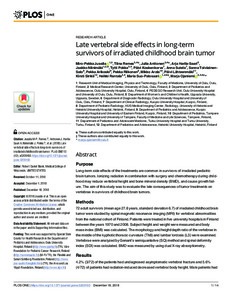Late vertebral side effects in long-term survivors of irradiated childhood brain tumor
Miro-Pekka Jussila; Tiina Remes; Julia Anttonen; Arja Harila-Saari; Jaakko Niinimäki; Tytti Pokka; Päivi Koskenkorva; Anna Sutela; Sanna Toiviainen-Salo; Pekka Arikoski; Pekka Riikonen; Mikko Arola; Päivi Lähteenmäki; Kirsti Sirkiä; Heikki Rantala; Maria Suo-Palosaari; Marja Ojaniemi
Late vertebral side effects in long-term survivors of irradiated childhood brain tumor
Miro-Pekka Jussila
Tiina Remes
Julia Anttonen
Arja Harila-Saari
Jaakko Niinimäki
Tytti Pokka
Päivi Koskenkorva
Anna Sutela
Sanna Toiviainen-Salo
Pekka Arikoski
Pekka Riikonen
Mikko Arola
Päivi Lähteenmäki
Kirsti Sirkiä
Heikki Rantala
Maria Suo-Palosaari
Marja Ojaniemi
PUBLIC LIBRARY SCIENCE
Julkaisun pysyvä osoite on:
https://urn.fi/URN:NBN:fi-fe2021042824299
https://urn.fi/URN:NBN:fi-fe2021042824299
Tiivistelmä
Purpose: Long-term side effects of the treatments are common in survivors of irradiated pediatric brain tumors. Ionizing radiation in combination with surgery and chemotherapy during childhood may reduce vertebral height and bone mineral density (BMD), and cause growth failure. The aim of this study was to evaluate the late consequences of tumor treatments on vertebrae in survivors of childhood brain tumors.
Methods: 72 adult survivors (mean age 27.8 years, standard deviation 6.7) of irradiated childhood brain tumor were studied by spinal magnetic resonance imaging (MRI) for vertebral abnormalities from the national cohort of Finland. Patients were treated in five university hospitals in Finland between the years 1970 and 2008. Subject height and weight were measured and body mass index (BMI) was calculated. The morphology and height/ depth ratio of the vertebrae in the middle of the kyphotic thoracic curvature (Th8) and lumbar lordosis (L3) were examined. Vertebrae were analyzed by Genant's semiquantative (SQ) method and spinal deformity index (SDI) was calculated. BMD was measured by using dual X-ray absorptiometry.
Results: 4.2% (3/72) of the patients had undiagnosed asymptomatic vertebral fracture and 5.6% (4/72) of patients had radiation- induced decreased vertebral body height. Male patients had flatter vertebrae compared with females. Patient age at the time of irradiation, BMI and irradiation area correlated to vertebral morphology differentially in males and females. BMD had no association with the vertebral shape. Patients who had received craniospinal irradiation were shorter than the general population.
Conclusion: Childhood brain tumor survivors had a high number of vertebral abnormalities in young adulthood. Irradiation was associated with abnormal vertebral morphology and compromised final height. Male gender may predispose vertebrae to the side effects of irradiation.
Kokoelmat
- Rinnakkaistallenteet [27094]
